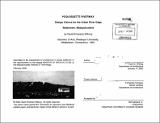| dc.contributor.advisor | Fernando Domeyko. | en_US |
| dc.contributor.author | Wiborg, David Emerson, 1970- | en_US |
| dc.contributor.other | Massachusetts Institute of Technology. Dept. of Architecture. | en_US |
| dc.coverage.spatial | n-us-ma | en_US |
| dc.date.accessioned | 2012-05-15T21:06:56Z | |
| dc.date.available | 2012-05-15T21:06:56Z | |
| dc.date.copyright | 2000 | en_US |
| dc.date.issued | 2000 | en_US |
| dc.identifier.uri | http://hdl.handle.net/1721.1/70725 | |
| dc.description | Thesis (M. Arch.)--Massachusetts Institute of Technology, Dept. of Architecture, 2000. | en_US |
| dc.description | Includes bibliographical references (p. 58-59). | en_US |
| dc.description.abstract | The thesis of this project is to activate and connect both sides of the Charles River for the community of Watertown. As of today, there has been a great deal of work to improve the recreational path linking Boston and Cambridge through Watertown to Waltham, Newton, and Weston. Nevertheless, the heavy car traffic of Watertown Square prohibits most of the community from engaging the river. Moreover, the people of Watertown need a place to gather and interact. This project will also provide a platform to receive visitors and performers from outside. The site selected to remedy this situation exists across the river from Watertown Square, and is currently isolated on three sides by roads and dominated by a vacated MBT A bus storage barn. The site's existing auto road, Nonantum Road, now abutting the river's edge, will be relocated to a widened existing Water Street to accommodate traffic. This change will result in a large gain of waterfront access for the town. Since the MBTA busses are no longer stored at this location, the bus barn will be razed to make way for a new complex. This new cluster of proposed buildings will secure a variety of inhabitable green parkland with outdoor performance pavilions, seating for individuals or groups, boat landings, and a promenade through the park. In addition, two new footbridges will physically link the site to the other side of the riverbank allowing residents to cross the river without encountering the dense vehicle traffic of the existing bridge. | en_US |
| dc.description.statementofresponsibility | by David Emerson Wiborg. | en_US |
| dc.format.extent | 70 p. | en_US |
| dc.language.iso | eng | en_US |
| dc.publisher | Massachusetts Institute of Technology | en_US |
| dc.rights | M.I.T. theses are protected by
copyright. They may be viewed from this source for any purpose, but
reproduction or distribution in any format is prohibited without written
permission. See provided URL for inquiries about permission. | en_US |
| dc.rights.uri | http://dspace.mit.edu/handle/1721.1/7582 | en_US |
| dc.subject | Architecture. | en_US |
| dc.title | Pequossette Riverway : design visions for the urban river edge, Watertown, Massachusetts | en_US |
| dc.type | Thesis | en_US |
| dc.description.degree | M.Arch. | en_US |
| dc.contributor.department | Massachusetts Institute of Technology. Department of Architecture | |
| dc.identifier.oclc | 45010224 | en_US |

